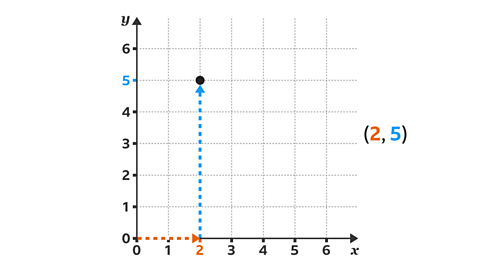Key points

Graphs of two or more straight lines can be used to solve simultaneous linear equations.
The graph of a straight line can be described using an equationA mathematical statement showing that two expressions are equal. The expressions are linked with the symbol =.
- horizontalThe right-left direction on a graph or map. Parallel to the horizon. lines are written as \(y = c\)
- verticalThe up-down direction on a graph or map. lines are written as \(x = c\)
- oblique lineA line that is slanted, neither horizontal nor vertical. are written as \(y = mx + c\)
\(m\) is a number which is a measure of the steepness of the line. This is the gradientA measure of the slope of a line. The steeper the line, the greater the gradient. The gradient is represented by đť’Ž in the equation đť’š = đť’Žđť’™ + đť’„.
\(c\) is the number where the line crosses the \(y\)-axis. This is the \(y\)đť’š-ľ±˛ÔłŮ±đ°ůł¦±đ±čłŮThe point at which the line crosses the đť’š-axis. Commonly referred to as 'the intercept'..
The coordinateThe ordered pair of numbers (đť’™, đť’š) that defines the position of a point. of the points on an oblique line are calculated by substituteIn algebra substitute means to replace a letter (or variable) with a number. given values of \(x\) into the equation \(y = mx + c\)

Recognise and draw the lines đť’š = đť’™ and đť’š = -đť’™
All the points on the line \(y = x\) have coordinates with equal values for \(x\) and \(y\)
- To draw the line \(y = x\):
- Plot points with coordinates where \(x\) and \(y\) are equal. Three points are sufficient, but more can be plotted.
- Draw a line through the plotted points.
All the points on the line \(y = -x\) have coordinates with values for \(x\) and \(y\) that are equal in magnitudeSize. but with opposite signs.
If \(x\) is positive, \(y\) is negative. If \(x\) is negative, \(y\) is positive.
- To draw the line \(y = -x\):
- Plot points with coordinates where \(x\) and \(y\) have equal magnitude but opposite signs.
- Draw a line through the plotted points.
Examples
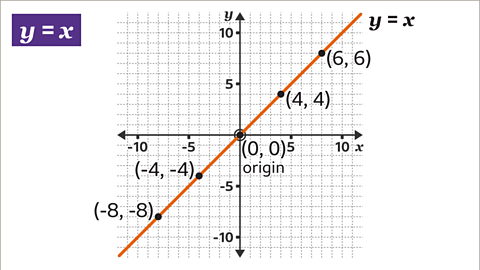
Image caption, The straight line đť’š = đť’™ passes through the origin. All the points on the line đť’š = đť’™ have coordinates with equal values for đť’™ and đť’š
Image caption, To draw the line đť’š = đť’™, plot points with coordinates where đť’™ and đť’š are equal. Although three points are sufficient, more points may be plotted. Using well-spaced points, such as the coordinates (-7, -7), (0, 0) and (8, 8), the line may be accurately drawn.
Image caption, Next, draw a line through the plotted points. Label the line đť’š = đť’™. The scales on the axes are equal, đť’š = đť’™ is a diagonal line passing through the origin.
Image caption, The straight line, đť’š = -đť’™ passes through the origin. All the points on the line đť’š = -đť’™ have coordinates with values for đť’™ and đť’š that are equal in magnitude but with opposite signs. If đť’™ is positive, đť’š is negative. If đť’™ is negative, đť’š is positive.
Image caption, To draw the line đť’š = -đť’™, plot points with coordinates where đť’™ and đť’š have equal magnitude but opposite signs. For example, the coordinates (-7, 7), (2, -2) and (9, -9) have đť’™ and đť’š values that are equal in size, but with opposite signs, one being positive and the other negative.
Image caption, Draw a line through the plotted points. Label the line đť’š = -đť’™. The scales on the axes are equal, đť’š = -đť’™ is a diagonal line passing through the origin.
1 of 6
Question
One graph shows \(y = x\) and one shows \(y = -x\). Which graph shows \(y = x\)?
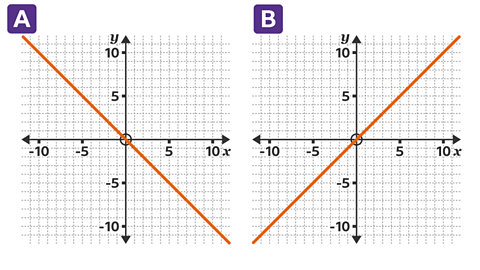
Graph B is \(y = x\).
All the coordinates have equal values for \(x\) and \(y\). This is shown by the points on the line such as (10, 10) and (-4, -4).
Graph A is \(y = -x\). All the coordinates have \(x\) and \(y\) values that are equal in magnitude but with opposite signs.
This is shown by the points on the line, such as (-6, 6) and (10, -10).

Draw the graph đť’š = đť’Žđť’™ + đť’„ by creating a table of values
\(m\) is a number which measures the steepness of the line. This is known as the gradient.
\(c\) is the number where the line crosses the \(y\)-axis. This is the \(y\)-intercept.
- To draw a graph of \(y = mx + c\) for given values of \(x\):
- Use the given values for \(x\) to draw a table of values for \(x\) and \(y\)
- substituteIn algebra substitute means to replace a letter (or variable) with a number. each value of \(x\) into the equation to find the valueof \(y\). Each pair of values give a coordinate.
- Use the coordinates to decide on axesTwo reference lines, one horizontal and one vertical, that cross at right-angles. They are used to define the position of a point on a grid. Axes is the plural of axis. that will take all the values of \(x\) and \(y\)
- Plot the coordinates and draw a line through the points. Label the line with the equation.
Example
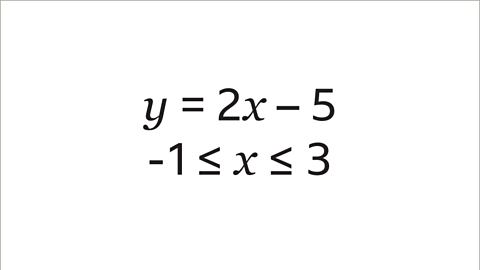
Image caption, Draw the graph of 𝒚 = 2𝒙 – 5 for values of 𝒙 from -1 to 3. This is written as the inequality -1 ≤ 𝒙 ≤ 3
Image caption, Use the given values for 𝒙 to draw a table for 𝒙 and 𝒚. -1 ≤ 𝒙 ≤ 3 means that the values of 𝒙 start at -1 and go up to 3
Image caption, Substitute each value of 𝒙 into the equation 2𝒙 – 5 to find the value of 𝒚. 2𝒙 – 5 means that each value of 𝒙 is multiplied by 2 and then 5 is subtracted to give 𝒚. When 𝒙 = -1, the calculation to find 𝒚 is -1 × 2 – 5. The process is repeated for each value of 𝒙
Image caption, Each calculation is evaluated to give 𝒚. When 𝒙 = -1 the calculation -1 × 2 – 5 gives 𝒚 = -7. When 𝒙 = 0 the calculation 0 × 2 – 5 gives 𝒚 = -5. Repeat this for each value of 𝒙
Image caption, Use the pairs of values in the table to list the coordinates of the points to be plotted. The coordinates are (-1, -7), (0, -5), (1, -3), (2, -1) and (3, 1).
Image caption, Use the coordinates to decide on axes that will take all the values of 𝒙 and 𝒚. The 𝒙-axis needs to include values from -1 to 3. This is shown as the inequality -1 ≤ 𝒙 ≤ 3. The 𝒚-axis needs to include values from -7 to 1. This is shown as the inequality -7 ≤ 𝒚 ≤ 1
Image caption, Plot the coordinates for 𝒚 = 2𝒙 – 5. Draw a line through the points and label the line.
Image caption, The đť’š-ľ±˛ÔłŮ±đ°ůł¦±đ±čłŮ of the graph is -5. This is the constant (đť’„) in the equation đť’š = 2đť’™ – 5. The line crosses the đť’š-axis at (0, -5).
Image caption, The gradient of the line 𝒚 = 2𝒙 – 5 is given by the coefficient of 𝒙 (2). For each one horizontal move to the right, the line moves vertically twice as much up. Eg, one horizontal unit to the right and two vertical units up. Similarly, four horizontal units to the right and eight vertical units up.
1 of 9
Questions
Question 1: Complete the table of values for \(y = 3x + 8\) for values of \(x\) from -2 to 2
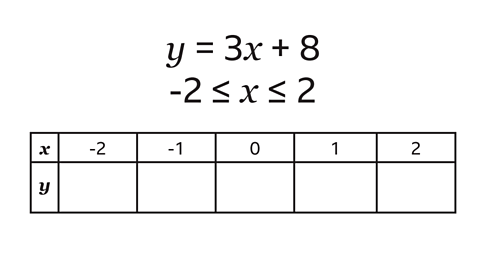
To find the values of \(y\), each value of \(x\) is multiplied by 3 and 8 is added on.
- When \(x\) is -2, the calculation is -2 Ă— 3 + 8. The value of \(y\) is 2
- When \(x\) is -1, the calculation is -1 Ă— 3 + 8. The value of \(y\) is 5
- When \(x\) is 0, the calculation is 0 Ă— 3 + 8. The value of \(y\) is 8
- When \(x\) is 1, the calculation is 1Ă— 3 + 8. The value of \(y\) is 11
- When \(x\) is 2, the calculation is 2 Ă— 3 + 8. The value of \(y\) is 14
The coordinates for \(y = 3x + 8\), given by the table, are
(-2, 2), (-1, 5), (0, 8), (1, 11), and (2, 14).
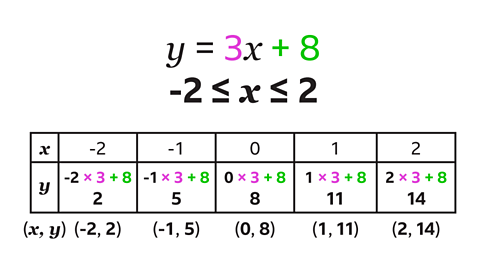
A table of values can also be used to find the coordinates of a line with a negative gradient.
Question 2: Complete the table of values for \(y = 3 – 2x\) for values of \(x\) from -1 to 3
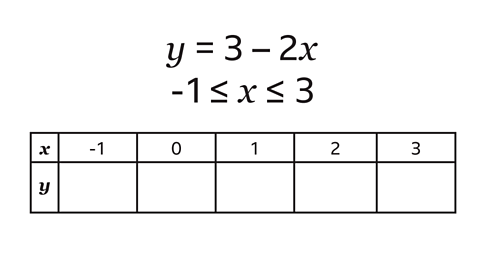
To find the values of \(y\), each value of \(x\) is multiplied by 2 and the result subtracted from 3
- When \(x\) = -1 the calculation is 3 – 2 × -1. The value of \(y\) is 5
- When \(x\) = 0 the calculation is 3 – 2 × 0. The value of \(y\) is 3
- When \(x\) = 1 the calculation is 3 – 2 × 1. The value of \(y\) is 1
- When \(x\) = 2 the calculation is 3 – 2 × 2. The value of \(y\) is -1
- When \(x\) = 3 the calculation is 3 – 2 × 3. The value of \(y\) is -3
The coordinates for \(y = 3x + 8\), given by the table, are
(-1, 5), (0, 3), (1, 1), (2, -1), and (3, -3).
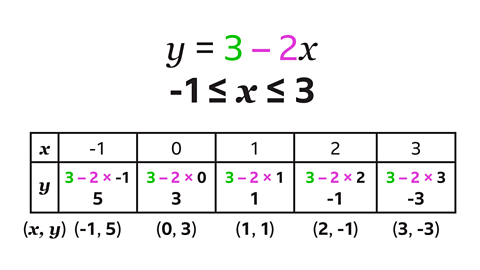
Reading đť’™ and đť’š coordinates from a graph
A position on a graph is defined by coordinates (\(x\), \(y\)). When one coordinate is given, the second can be read from the graph.
To find a \(y\)-coordinate from a given \(x\)-coordinate:
- On the \(x\)-axis, locate the given amount.
- Draw a vertical line, using a ruler, from the given amount up to the line.
- Draw a horizontal line, using a ruler, from the line across to the \(y\)-axis.
- Read the value on the \(y\)-axis.
To find an \(x\)-coordinate from a given \(y\)-coordinate:
- On the \(y\)-axis, locate the given amount.
- Draw a horizontal line, using a ruler, from the given amount across to the line.
- Draw a vertical line, using a ruler, from the line down to the \(x\)-axis.
- Read the value on the \(x\)-axis.
Examples
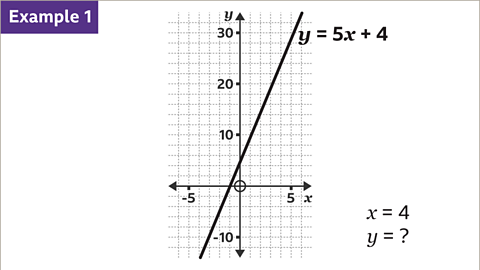
Image caption, Use the graph to find the value of đť’š when đť’™ = 4
Image caption, On the đť’™-axis, locate the given amount (4) and draw a vertical line, using a ruler, up to the line.
Image caption, Then, draw a horizontal line, using a ruler, from the line across to the đť’š-axis. Read the value on the đť’š-axis. When đť’™ = 4, đť’š = 24
Image caption, Use the graph to find the value of đť’™ when đť’š = 2
Image caption, On the đť’š-axis, locate the given amount (2) and draw a horizontal line, using a ruler, across to the line.
Image caption, Draw a vertical line, using a ruler, from the line down to the đť’™-axis. Read the value on the đť’™-axis. When đť’š = 2, đť’™ = 12
1 of 6
Question
Use the graph to find the value of \(x\) when \(y = 3\)
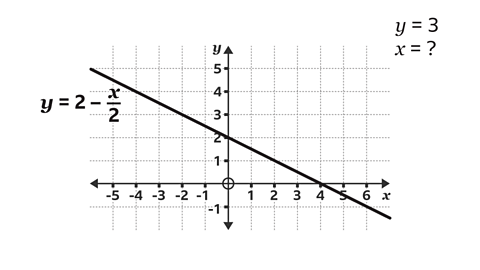
On the \(y\)-axis, locate the given amount (3) and draw a horizontal line, using a ruler, across to the line.
Draw a vertical line, using a ruler, from the line down to the \(x\)-axis and read the value on the \(x\)-axis.
When \(y\) = 3, \(x\) = -2
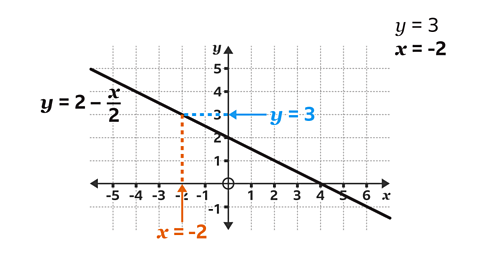
Practise reading and plotting linear equation graphs
Quiz
Practise reading and plotting linear equation graphs with this quiz. You may need a pen and paper to help you.
Real-life maths

Linear graphs are commonly used when converting between different units of measurement.
For example, swapping between temperatures in degrees Celsius (°C) and degrees Fahrenheit (°F), exchanging between different currencies, such as pounds and euros, or changing inches into centimetres.


Linear graphs are useful to pharmacists and scientists in the pharmaceutical industry when working out the correct strength of drugs.
The amount of a drug for a given volume of medicine is critical, both for the medicine to be effective and for the safety of the patient.
Game - Divided Islands
Play the Divided Islands game! gamePlay the Divided Islands game!
Using your maths skills, help to build bridges and bring light back to the islands in this free game from ±«Óătv Bitesize.

More on Graphs
Find out more by working through a topic
- count6 of 7
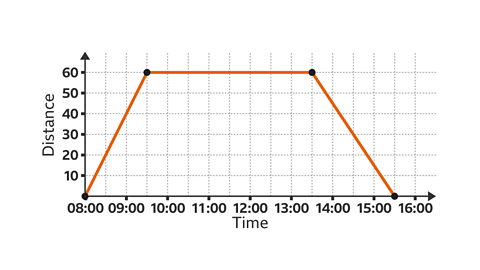
- count7 of 7
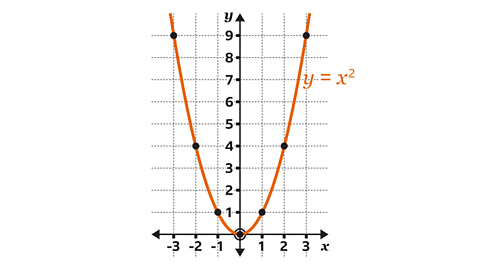
- count1 of 7
